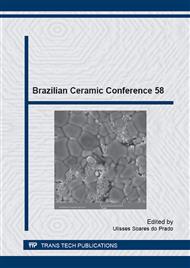p.280
p.287
p.293
p.297
p.303
p.309
p.315
p.320
p.325
Evaluation of the Cytotoxicity of NiFe2O4/SiO2 Hybrid Nanoparticles Aiming its Application as Drug Carriers
Abstract:
Magnetic nanoparticles have potential application in biomedicine since their features allow a wide variety of applications, such as drug carriers, destruction of tumor cells and magnetic separation of cells and proteins. Overlooking that, the proposal is to obtain the hybrid NiFe2O4/SiO2 from the surface modifying with the 3-aminopropyltriethoxysilane, and evaluate the structure, morphology and cytotoxicity, to obtain a biocompatible hybrid for biological applications, such as, e.g., drug carrier. The samples were analyzed by XRD, FTIR, SEM, magnetic measurements and cytotoxicity. The results showed the formation of single phase of the NiFe2O4 spinel with crystallite size of 35 and 32 nm referring to the samples before and after the surface modification, and presence of characteristic absorption bands of the spinel and of the silanol group from the silane agent, confirming the hybrid formation. The presence of the silane agent kept the ferrimagnetic characteristic and increased the cell viability, making it a non-cytotoxic material.
Info:
Periodical:
Pages:
303-308
Citation:
Online since:
June 2015
Keywords:
Price:
Сopyright:
© 2015 Trans Tech Publications Ltd. All Rights Reserved
Share:
Citation:


